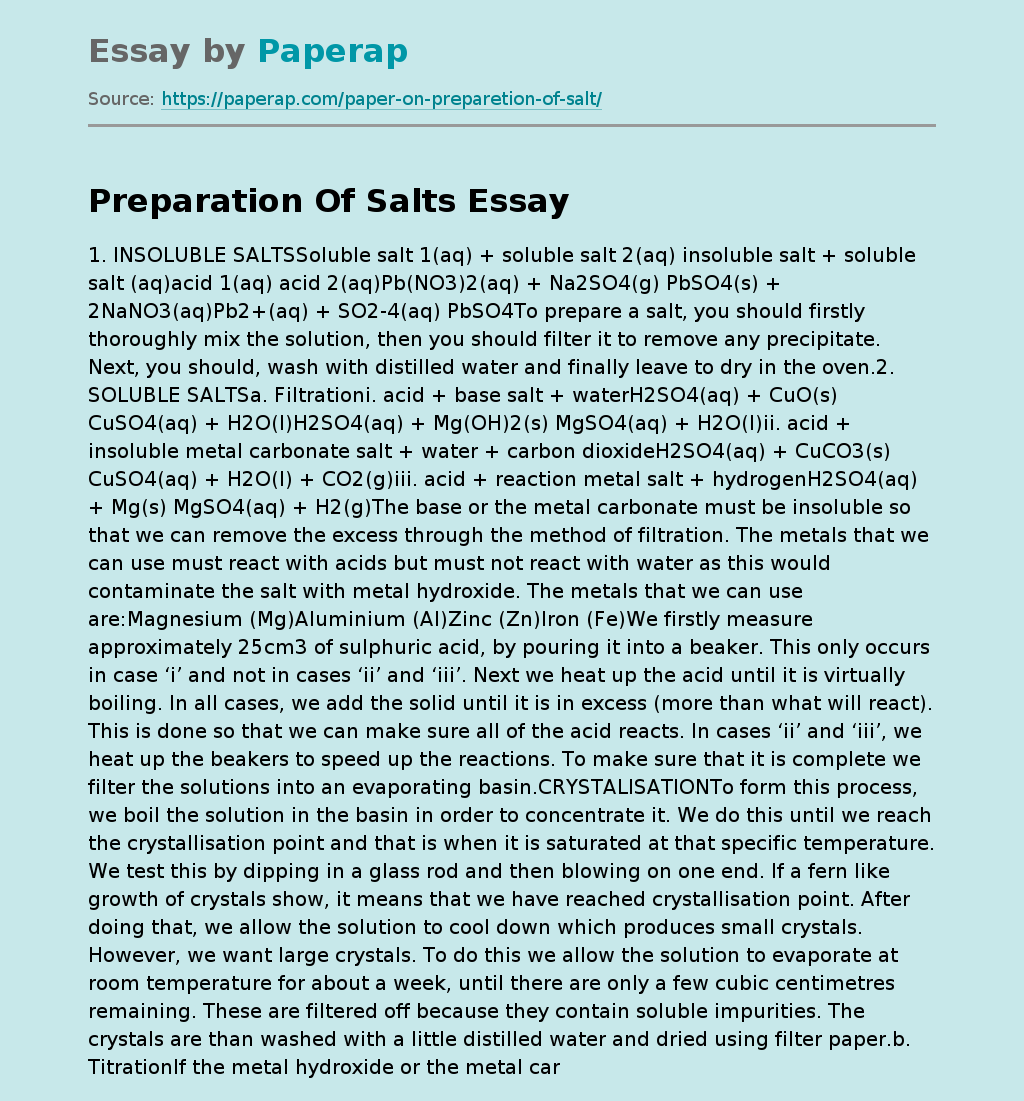1. INSOLUBLE SALTSSoluble salt 1(aq) + soluble salt 2(aq) insoluble salt + soluble salt (aq)acid 1(aq) acid 2(aq)Pb(NO3)2(aq) + Na2SO4(g) PbSO4(s) + 2NaNO3(aq)Pb2+(aq) + SO2-4(aq) PbSO4To prepare a salt, you should firstly thoroughly mix the solution, then you should filter it to remove any precipitate. Next, you should, wash with distilled water and finally leave to dry in the oven.2. SOLUBLE SALTSa. Filtrationi. acid + base salt + waterH2SO4(aq) + CuO(s) CuSO4(aq) + H2O(l)H2SO4(aq) + Mg(OH)2(s) MgSO4(aq) + H2O(l)ii.
acid + insoluble metal carbonate salt + water + carbon dioxideH2SO4(aq) + CuCO3(s) CuSO4(aq) + H2O(l) + CO2(g)iii. acid + reaction metal salt + hydrogenH2SO4(aq) + Mg(s) MgSO4(aq) + H2(g)The base or the metal carbonate must be insoluble so that we can remove the excess through the method of filtration. The metals that we can use must react with acids but must not react with water as this would contaminate the salt with metal hydroxide.
The metals that we can use are:Magnesium (Mg)Aluminium (Al)Zinc (Zn)Iron (Fe)We firstly measure approximately 25cm3 of sulphuric acid, by pouring it into a beaker. This only occurs in case ‘i’ and not in cases ‘ii’ and ‘iii’. Next we heat up the acid until it is virtually boiling. In all cases, we add the solid until it is in excess (more than what will react). This is done so that we can make sure all of the acid reacts.
In cases ‘ii’ and ‘iii’, we heat up the beakers to speed up the reactions. To make sure that it is complete we filter the solutions into an evaporating basin.CRYSTALISATIONTo form this process, we boil the solution in the basin in order to concentrate it. We do this until we reach the crystallisation point and that is when it is saturated at that specific temperature. We test this by dipping in a glass rod and then blowing on one end. If a fern like growth of crystals show, it means that we have reached crystallisation point. After doing that, we allow the solution to cool down which produces small crystals. However, we want large crystals. To do this we allow the solution to evaporate at room temperature for about a week, until there are only a few cubic centimetres remaining. These are filtered off because they contain soluble impurities. The crystals are than washed with a little distilled water and dried using filter paper.b. TitrationIf the metal hydroxide or the metal carbonate are soluble, (i.e. alkalis), we cannot remove the excess via the process of filtration. Therefore, we have to react these substances in their correct stoichiometric amounts (i.e. there is no excess of either of them). This is done by a process known as titration.All sodium (Na) and potassium (K) salts have to be prepared by titration as their hydroxides and carbonates are soluble.i. base of soluble metal hydroxide + acid salt + waterNaOH(aq) + HCl(aq) NaCl(aq) + H2O(l)ii. metal carbonate + acid salt + water + carbon dioxideNa2CO3(aq) + H2SO4(aq) Na2SO4(aq) + H2O(l) + CO2(g)Here are some pictures of the equipment that we need for this experiment:graduation pointThe pipette is used for measuring out with a fixed volume of solution. We firstly wash it out with the solution that we are going to use. In our case we are using hydrochloric acid.We then pipette 20cm3 of the acid into a conical flask. Then we then add a few drops of universal indicator to the solution.A burette is used for measuring a variable volume of solution. We also (like with the pipette) wash out the burette with alkali, which happens to sodium hydroxide in this case. We firstly fill the burette with the prescribed alkali through a funnel until the alkali reaches 0cm3.The alkali is very caustic. This means it will wear away into wood or anything in its way. The only way to stop this from happening, is to neutralise it by pouring an acid over it.We then titrate the hydrochloric acid solution with the solution from the burette until we reach the ‘equivalence point,’ (end point).The indicator should abruptly change colour from red to a mid-range colour, orange. You should wash out the conical flask with water and repeat to get consistent titres which are within 0.2cm3 of each other. We repeat the whole thing using the same volumes but no indicators so the final colour of the solution is not changed. We then crystallise the solution as normal.Here are some results from this experiment overleaf:ATTEMPTROUGHONETWOFINAL22.3021.0042.10INITIAL-1.200.0021.00TITRE21.1021.0021.10c. EvaporationAnother method of making ammonium nitrate is done when either the acid or the alkali is volatile (evaporates easily). An example of this is for an acid -hydrochloric acid or for an alkali – ammonia. In these cases we do not need to use the process of titration to prepare the salt. We can simply add the excess of the one that is volatile and the excess will evaporate when we come to evaporate the solution.NH3(aq) + HNO3(aq) NH4NO3(aq)We measure out approximately 20cm3 of nitric acid into an evaporating basin. We then add ammonia solution while stirring until in excess. We can check for this by its smell and confirm it is in excess by using red litmus paper which should turn blue. We then crystallise the solution as usual where upon the excess ammonia will evaporate.
Preparation Of Salts. (2019, Dec 05). Retrieved from https://paperap.com/paper-on-preparetion-of-salt/

